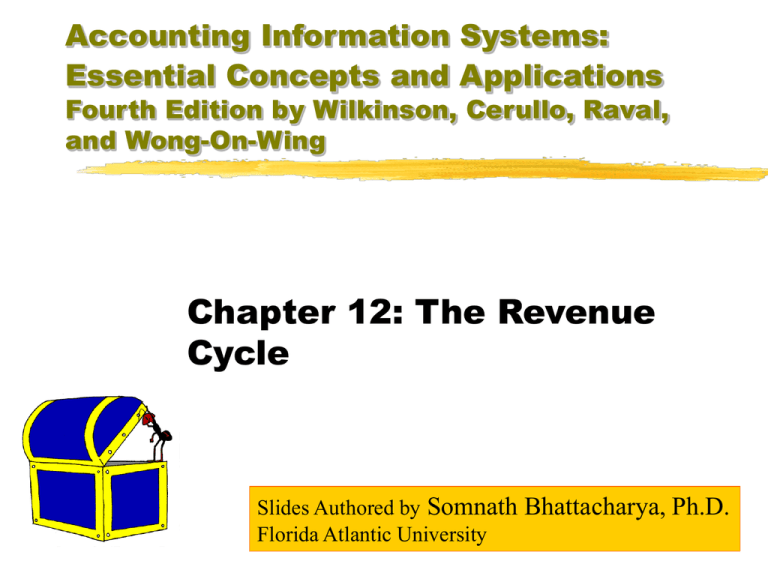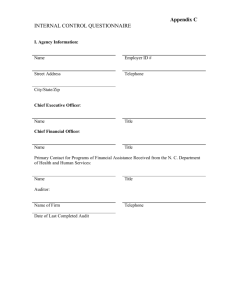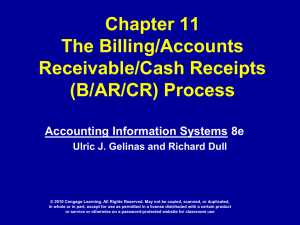
Accounting Information Systems:
Essential Concepts and Applications
Fourth Edition by Wilkinson, Cerullo, Raval,
and Wong-On-Wing
Chapter 12: The Revenue
Cycle
Slides Authored by Somnath Bhattacharya, Ph.D.
Florida Atlantic University
Introduction
Revenue Cycles tend to be similar for all
types of firms.
Two subsystems perform the processing
steps within the revenue cycle:
The Sales Processing System
The Cash Receipts Processing System
Objectives of the Revenue
Cycle
To record sales orders promptly and accurately
To verify that the customers are worthy of credit
To ship the products or perform the services by agreed
dates
To bill for products or services in a timely and an
accurate manner
To record and classify cash receipts promptly and
accurately
To post sales and cash receipts to proper customers’
accounts in the accounts receivable ledger
To safeguard products until shipped
To safeguard cash until deposited
Marketing/Distribution
Marketing Management has the
objectives of
Determining and satisfying the
needs of customers
Generating sufficient revenue to cover costs
and expenses
Replacing assets
Providing an adequate return on investment
Finance/Accounting
With respect to the Revenue
Cycle, the objectives are
limited to
Cash Planning and Control
Data pertaining to sales and customer
accounts
Inventory control
Information pertaining to cash, sales, and
customers
Input Documents Pertaining to
the Revenue Cycle
Customer Order
Sales Order
Order
Acknowledgement
Picking List
Packing Slip
Bill of Lading
Shipping Notice
Sales Invoice
Remittance Advice
Deposit Slip
Back Order
Credit Memo
Credit Application
Salesperson Call
Report
Delinquent Notice
Write-off Notice
Cash Register
Receipts
Figure 12-2
DFD of a Sales & Receivables
Processing System
Order Data
Customer
1.0
Credit
Data
Receive &
Enter Sales
Order
Customer Data
Shipping Data
Inventory Data
Inventory Data
2.0
Ship
Goods to
Customers
3.0
Bill
Customer
Customer
General Ledger
Account Data
Order Data
Receivables Data
Figure 12-5. See
Textbook for details
Accountants &
Managers
Sales Data
4.0
Prepare
Accounting
Analyses &
Reports
Customer Data
Pricing Data
Sales History
Credit Sales Processing
System
Order Entry
Customer Order
Picking List
Shipping
Bill of Lading
Billing
Preparing Analyses & Reports
Invoice Register
Accounts Receivable Summary
Handling Sales Returns & Allowances
Credit Memos
Processing Back Orders
Cash Receipts Processing
System
Remittance Entry
Remittance List
Lockbox
Depositing Receipts
Deposit Slips
Cash Receipts Transaction Listing
Posting Receipts
Balance Forward Method
Open Invoice Method
Preparing Analyses & Reports
Collecting Delinquent Accounts
Write-off Notice
Web-Based Systems
Electronic commerce
Larger customer base
Quicker processing of transactions
Less paperwork
Greater efficiency & productivity
Self-service
AICPA’s Web-Trust and competing services
Information Output
Operational Listings & Reports
Inquiry Display Screens
Scheduled Managerial Reports
Demand Managerial Reports
Operational Listings and
Reports
Monthly statement
Open orders report
Sales Invoice register
Shipping register
Cash receipts journal
Credit memo register
Scheduled Managerial
Reports
Accounts receivable aging schedule
Reports on critical factors
Average dollar value per order
Percentage of orders shipped on time
Average number of days between the order
date and shipping date
Sales analyses
Salesperson
Sales region
Product lines
Customers
Markets
Cash flow statements
Demand Managerial
Reports
Demand reports are ad hoc nonscheduled reports
“What-if” scenarios
Types of Managerial Decisions
Pertaining to the Revenue Cycle
Marketing decisions
Which types of markets and customers are to be served?
Which specific products are to be provided to customers,
including new products to be introduced?
What prices are to be charged, and what discounts are to be
allowed?
What after-sales services are to be offered?
What channels of distribution are to be employed?
What advertising media are to be employed, and in what mix?
What organizational units are to be incorporated within
the marketing function?
What marketing plans and budgets are to be established for the
coming year?
Figure 12-17
Types of Managerial Decisions
Pertaining to the Revenue Cycle
Financial Decisions
What criteria are to be employed in granting credit to potential
customers?
What collection methods are to be employed in minimizing bad
debts?
What accounts receivable records are to be maintained
concerning amounts owed by customers?
What sources, other than receipts from sales, are to be
employed in obtaining needed funds for operations?
What financial plans and cash budgets are to be established for
the coming year?
Figure 12-17 Continued
Typical Files Associated
with the Revenue Cycle
Master Files
Customer master file
Accounts receivable master file
Merchandise inventory master file
Transaction & Open Document Files
Sales order file
Open sales order file
Sales invoice transaction file
Cash receipts transaction file
Other Files
Shipping & Price data reference file
Credit reference file
Salesperson file
Sales history file
Cash receipts history file
Accounts receivable report file
Figure 12-18
A Layout of an Accounts
Receivable Record
Customer Customer Credit
Account
Name
Limit
Balance
Figure 12-19
Balance
Year-toBeginning date
of Year
Sales
Year-toCurrent
date
Account
Payments Balance
Relational Data Structure for the
Sales Aspect of the Revenue Cycle
Customer Customer Customer Phone Credit Trade Account Balance Year-to-date Year-to-date
Number
Name
Shipping Number Limit Discount Beginning of Year Sales
Payments
Address
Allowed
Sales
Order
Product
Number
Quantity
Ordered
Sales
Order Expected Salesperson Customer
Order Date Delivery Code
Number
Number
Date
Product Description Warehouse Unit of Reorder Economic Unit Name of Quantity on Quantity on
Number
Location Measure Point Reorder Cost Preferred Order
Hand
Quantity
Supplier
Sales
Customer Sales Billing Shipping
Terms Total
Invoice Number Order (Invoice) Document
Sales
Number
Number Number
Amount
Sales
Invoice
Number
Product
Number
Unit
Price
Quantity Shipped
and Sold
Figure 12-21
Risk Exposures in the
Revenue Cycle - I
Risk
Exposure
1) Credit sales made to customers
who represent poor credit risks
1) Losses from bad debts
2) Unrecorded or unbilled shipments
2) Losses of revenue; overstatement
of inventory and understatement of
accounts receivable in the balance
sheet
3) Alienation of customers and
possible loss of future sales; losses of
revenue
3) Errors in preparing sales invoices
Figure 12-22
Risk Exposures in the
Revenue Cycle - II
Risk
Exposure
4) Misplacement of orders from
customers or unfilled backorders
4) Losses of revenue and alienation of
customers
5) Incorrect posting of sales to
accounts receivable records
5) Incorrect balances in accounts
receivable and general ledger account
records
6) Posting of revenues to wrong
6) Overstatement of revenue in one
accounting periods, such as premature year (year of premature booking) and
booking of revenues
understatement of revenue in the next
Figure 12-22 (continued)
Risk Exposures in the
Revenue Cycle - III
Risk
Exposure
7) Fictitious credit sales to nonexistent Overstatement of revenues and
customers
accounts receivable
8) Excessive sales returns and
allowances with certain of the credit
memos being for fictitious returns
9) Theft or misplacement of finished
goods in the warehouse or on the
shipping dock
Figure 12-22 (continued)
8) Losses in net revenue, with the
proceeds from subsequent payments
by affected customers being
fraudulently pocketed
9) Losses in revenue; overstatement
of inventory on the balance sheet
Risk Exposures in the
Revenue Cycle - IV
Risk
10) Fraudulent write-offs of
customers’ accounts by unauthorized
persons
Exposure
10) Understatement of accounts
receivable; losses of cash receipts
when subsequent collections on
written-off accounts are
misappropriated by perpetrators of the
fraud
11) Theft (skimming) of cash receipts, 11) Losses of cash receipts;
especially currency, by persons
overstatement of accounts receivable
involved in the processing; often
in the subsidiary ledger and the
accompanied by omitted postings to
balance sheet
affected customers’ accounts
12) Lapping of payments from
12) Losses of cash receipts; incorrect
customers when amounts are posted account balances for those customers
to accounts receivable records
whose records are involved in the
lapping
Figure 12-22 (continued)
Risk Exposures in the
Revenue Cycle - V
Risk
Exposure
13) Accessing of accounts receivable,
merchandise inventory, and other
records by unauthorized persons
14) Involvement of cash, merchandise
inventory, and accounts receivable
records in natural or human-made
disasters
15) Planting of virus by disgruntled
employee to destroy data on magnetic
media
13) Loss of security over such records,
with possibly detrimental use made of
the data accessed
14) Losses of or damages to assets
Figure 12-22 (continued)
15) Loss of customer accounts
receivable data needed to monitor
collection of amounts from previous
sales
Risk Exposures in the
Revenue Cycle - VI
Risk
Exposure
16) Interception of data transmittal
between customers and the web site
16) Loss of data which may be used to
the detriment of customers
17) Unauthorized viewing and
alteration of other customer account
data via the Web
18) Denial by a customer that an
online order was placed after the
transaction is processed
17) Loss of security over customer
records resulting in misstatement of
accounts receivable balances
18) Loss of sales revenues
Figure 12-22 (continued)
Risk Exposures in the
Revenue Cycle - VII
Risk
Exposure
19) Use of stolen credit cards to place
orders via the Web
19) Loss of shipped goods for which
payments will not be received
20) Breakdown of the web server due
to unexpectedly high volume of
transactions
20) Loss of sales revenues and
alienation of customers
Figure 12-22 (continued)
Typical Control Objectives
for the Revenue Cycle
All customers accepted for credit sales are credit-worthy
All ordered goods are shipped, and all services are
performed by dates that are agreeable to all parties
All shipped goods are authorized and accurately billed
within the proper accounting period
All sales returns and allowances are authorized and
accurately recorded and based on actual return of goods
All cash receipts are recorded completely and accurately
All credit sales and cash receipts transactions are posted
to proper customers’ accounts in the accounts receivable
ledger
All accounting records, merchandise inventory,
and cash are safeguarded
General Controls of the
Revenue Cycle - I
Organizational Controls
Units with custodial functions should be kept
separate from each other
Custodial functions should furthermore be
segregated from record-keeping functions
For computerized systems, systems
development should be kept separate from
systems operations
General Controls of the
Revenue Cycle - II
Documentation Controls
Asset Accountability Controls
Management Practice Controls
Data Center Operations Controls
Authorization Controls
General Controls of the
Revenue Cycle - III
Access Controls
Assigned passwords that authorized clerks must enter to access
accounts receivable and other customer-related files, in order to
perform their strictly defined tasks
Terminals that are restricted in the functions they allow to be
performed with respect to sales and cash receipts transactions
Logging of all sales and cash receipt transactions upon their
entry into the system
Frequent dumping of accounts receivable and merchandise
inventory master files onto magnetic tape backups
Physically protected warehouses and safes
A lockbox collection system in situations where feasible
Application Controls of the
Revenue Cycle: Input - I
1) Prepare pre-numbered and welldesigned documents relating to sales,
shipping, and cash receipts, with each
prepared document being approved by an
authorized person
2) Validate data on sales orders and
remittance advices as the data are
prepared and entered for processing. In
computer-based systems, validation
should be performed by means of
programmed edit checks. When data are
keyed into computer-readable medium,
key verification is also appropriate
Application Controls of the
Revenue Cycle: Input - II
3) Correct errors that are detected during
data entry and before the data are posted
to the customer and inventory records
4) Precompute batch control totals
relating to key data on sales invoices (or
shipping notices) and remittance advices.
These precomputed batch control totals
should be compared with totals computed
during postings to the accounts receivable
ledger and during each processing run.
In the case of cash receipts, the total on
remittance advices should also be
compared with the total on deposit slips
Application Controls of the
Revenue Cycle: Processing - I
1) Move ordered goods from the finished goods
warehouse and ship the goods only on the basis
of written authorizations such as stock request
copies
2) Invoice customers only on notification by the
shipping department of the quantities that have
been shipped
3) Issue credit memos for sales returns only
when evidence (i.e. receiving report) has been
received that the goods were actually returned
4) Verify all computations on sales invoices
before mailing and postings to proper
customers’ accounts. Also, compare the sales
invoices against shipping notices and open
orders, in order to ensure that the quantities
ordered reconcile with the orders shipped and
back-ordered
Application Controls of the
Revenue Cycle: Processing - II
5) Verify that total amounts posted to the
accounts receivable accounts from batches of
transactions agree with precomputed batch
totals, and post the total amounts to the
appropriate general ledger accounts
6) Deposit all cash received intact and with a
minimum of delay, thus eliminating the
possibility of cash receipts being used to pay
employees or to reimburse petty cash funds
7) Correct errors that are made during
processing steps, usually by reversing erroneous
postings to accounts and entry of correct data.
The audit trail concerning accounts being
corrected should show the original errors, the
reversals, and the corrections
Application Controls of the
Revenue Cycle: Output
1) Prepare monthly statements, which should be
mailed to all credit customers, especially if the
balance forward approach is employed
2) File copies of all documents pertaining to
sales and cash receipts transactions by number,
with the sequence of numbers in each file being
periodically checked to see if gaps exist. If
transactions are not supported by preprinted
documents, as often is the case in online
computer-based systems, assign transaction
numbers to the transactions
3) Prepare printed transaction listings and
account summaries on a periodic basis in order
to provide audit trail and a basis for review
Web Security Procedures
Authentication
Authorization
Use of an Access Control List
Accountability
Data Transmission
Disaster Contingency & Recovery Plan
Accounting Information Systems:
Essential Concepts and Applications
Fourth Edition by Wilkinson, Cerullo,
Raval, and Wong-On-Wing
Copyright © 2000 John Wiley & Sons, Inc. All rights reserved.
Reproduction or translation of this work beyond that permitted in
Section 117 of the 1976 United States Copyright Act without the express
written permission of the copyright owner is unlawful. Request for
further information should be addressed to the Permissions Department,
John Wiley & Sons, Inc. The purchaser may make back-up copies for
his/her own use only and not for distribution or resale. The publisher
assumes no responsibility for errors, omissions, or damages, caused by
the use of these programs or from the use of the information contained
herein.




